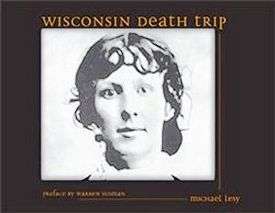Wisconsin Death Trip
Wisconsin Death Trip is a 1973 non-fiction book by Michael Lesy, based on a collection of late 19th century photographs by Jackson County, Wisconsin, photographer Charles Van Schaick – mostly taken in the city of Black River Falls – and local news reports from the same period. It emphasizes the harsh aspects of Midwestern rural life under the pressures of crime, disease, mental illness, and urbanization.

The book was adapted into a film in 1999.
Film adaptation
The 1999 film adaptation was directed by James Marsh as a docudrama. It was shot primarily in black-and-white, with contrasting color sequences of modern life in the area. It combined re-enactments of some of the events described in the book with a voice-over narration by Ian Holm. Its visual style was intended to carry the content of the film; as Marsh said:
I wanted to convey in the film the real pathos contained in a four line newspaper report that simultaneously records and dismisses the end of someone's life.[1]
In popular culture
Music
The book inspired a number of musical works, including the opera Black River by Conrad Susa, which was composed in 1975 and revised 1981; the "dramatic cantata" Songs of Madness and Sorrow by Daron Hagen; and the 1999 album Wisconsin Death Trip by the band Static-X. British post-punk band Echo & the Bunnymen used photographs from the book as artwork for their 2001 album Flowers, as well as its singles. A song performed by Jerry Joseph was inspired by the title of the film.[2] Most recently, the book was adapted into a bluegrass/roots-rock opera by Tim Raphael and composer Jeff Berkson, which had its world premiere at Georgetown University's Davis Performing Arts Center on February 1, 2008. The soundtrack for the film adaptation of the book features original music by DJ Shadow and John Cale.
Literature
The Australian author Rod Jones cites Wisconsin Death Trip as an inspiration for his novel Billy Sunday, and the American author Robert Goolrick also cites it as an inspiration for his novel A Reliable Wife. Stephen King's book of novellas, Full Dark, No Stars, cites Wisconsin Death Trip as the inspiration for the story 1922. The American author Stewart O'Nan "acknowledges his great debt to Michael Lesy," citing Wisconsin Death Trip as an inspiration for his novel A Prayer for the Dying. (NB: at least one early Picador edition misattributes this to "Michael Levy".)
Film
In commentary on the two-disc DVD release of the Bob Dylan biopic I'm Not There, director Todd Haynes said that much of the imagery for the town of Riddle in the Richard Gere segment of the film was inspired by Lesy's book. Director Walter Murch also used the book as an historical source for the 1985 cult classic Return to Oz.[3]
Television
The creators of the show The Heart, She Holler have discussed being influenced by the book in the creation of their show about rural America.[4]
References
Notes
- http://www.wisconsindeathtrip.com/about.html
- http://www.jerryjoseph.com/lyrics/self-titled-lyrics/
- Ondaatje, Michael (2002). The Conversations: Walter Murch and the Art of Editing Film. p. 6.
- Czajkowski, Elise. "Inside the Inbred Horror Comedy of 'The Heart, She Holler'" Splitsider (December 26, 2013)
External links
- Wisconsin Death Trip audio slide show - includes an interview with Michael Lesy, images from the book, and other Victorian post-mortem photographs
- Wisconsin Death Trip Images on WHS Images - Wisconsin Historical Society digital collection of photographs taken by Charles Van Schaick and used in Wisconsin Death Trip
- Photographs by Charles Van Schaick on WHS Images - Wisconsin Historical Society digital collection of all photographs taken by Charles Van Schaick
- Wisconsin Death Trip - official site for the film